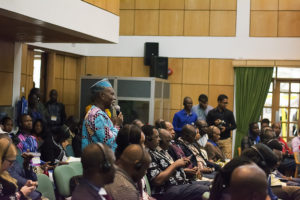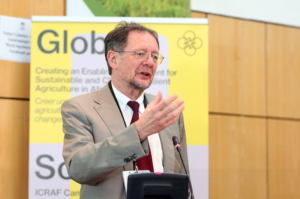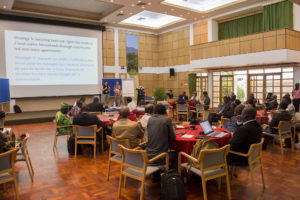The Global Soil Week (GSW) is a platform piloted by TMG Think Tank bringing together a diverse range of actors to initiate and strengthen policies and actions on sustainable soil management and responsible land governance. Since its beginning in 2012, the focus and design of the GSW has continuously evolved in order to respond to and shape ongoing policy debates and land management programming. Multiple events and meetings are taken place every year to translate global goals into local realities and priorities, and a conference gathering the international network of partners together is organized every two years.




The GSW is embedded into the multilevel governance processes of the Agenda 2030. Achieving sustainable development according to the 2030 Agenda in all countries of the world is a challenge and at the same time a once in a generation opportunity. Addressing the multiple linkages between the different SDGs and across countries requires novel and innovative ways to navigate the complexity of the agenda. Additionally, it is necessary to ensure that national activities do not jeopardize achievements at the global level. This is a task for follow-up and review processes on the 2030 Agenda which, when well-designed, can make thematic and cross- country linkages visible to support national level implementation.
The Global Soil Week 2019 summary report can be consulted both in English and in French.
WHY SOIL?
Soils and land provide the basis for more than 95% of the food produced in the world and support the livelihoods of smallholder farmers and agricultural workers (in some places, as much as 70% of them are women). Due to global demographic changes, cropland per capita has fallen by more than half since 1960. Land tenure regimes that marginalize certain population groups exacerbate this scarcity. Their pollution has direct impacts on our health and other ecosystems such as the oceans.
Nearly one-quarter (24%) of the world’s land area is affected by degradation, thereby negatively influencing the livelihoods of 1.5 billion people worldwide. For example, soil and land degradation, and poor soil fertility in particular, is widely accepted as the most critical factor in limiting agricultural production in Sub-Saharan Africa.
Soil and land resources are key to achieving several of the SDGs. They are implicit in several of the goals, which is a feature that they share with other natural resources like forests or biodiversity. Piloting a preparatory event to the HLPF 2017 that focuses on soil and land will therefore also yield insights into follow-up and review methodologies for the 2030 Agenda in general and for other natural resources in particular.